Direct Payment and Agricultural Subsidy: A Comparative Analysis
VerifiedAdded on 2022/11/01
|8
|1534
|455
Report
AI Summary
This report delves into the advantages of direct payment (DP) over production-linked farm support schemes, exploring its benefits such as reduced production pressure and less trade distortion. It analyzes why DP is popular in developing countries, highlighting its transparency and ability to provide fixed income, contrasting it with the challenges of traditional subsidy models. The report also assesses how farmers in New Zealand might react to DP in other developed nations, considering potential impacts on international trade and market distortion. It references key studies to support its findings, providing a comprehensive overview of the topic and its implications for agricultural policy.
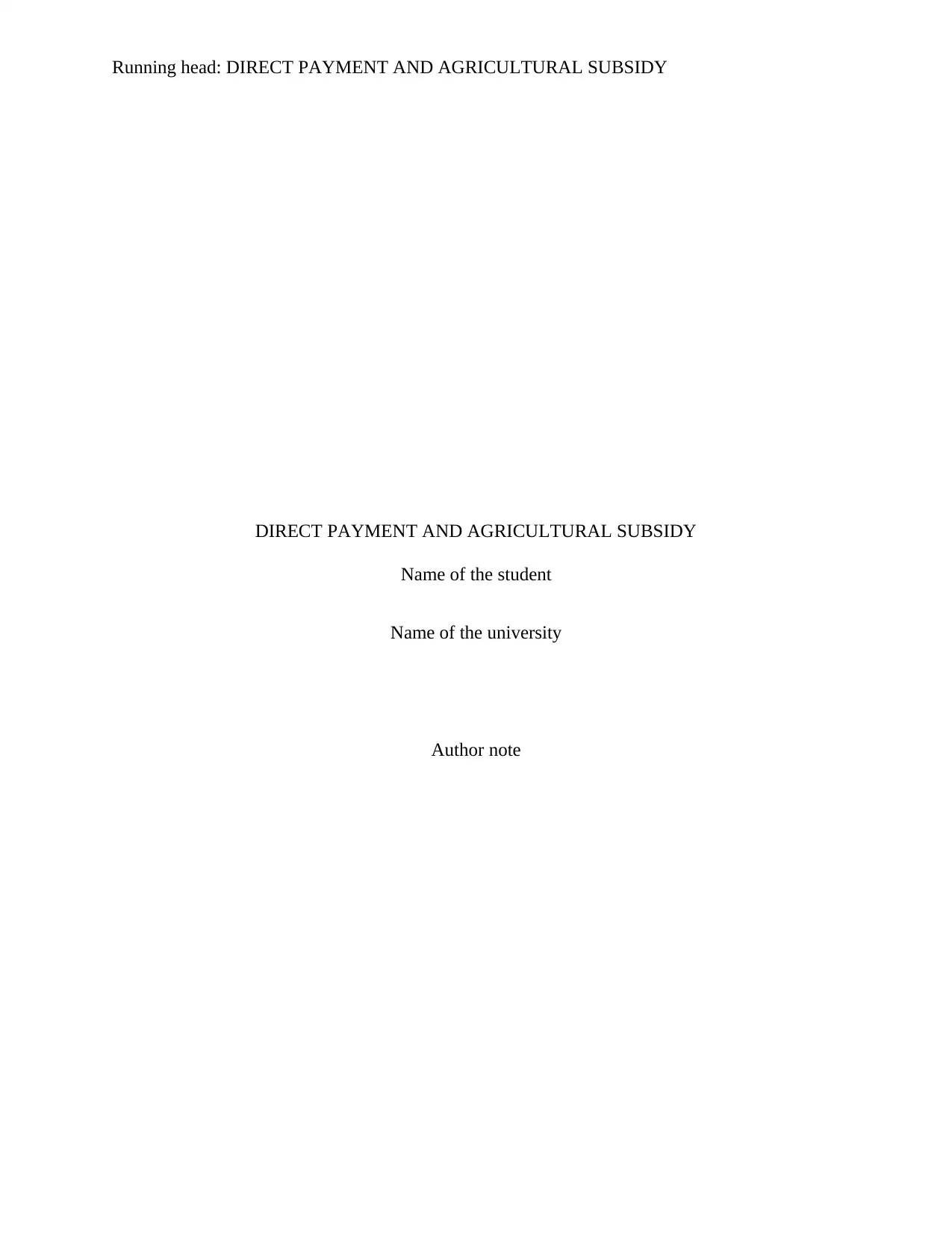
Running head: DIRECT PAYMENT AND AGRICULTURAL SUBSIDY
DIRECT PAYMENT AND AGRICULTURAL SUBSIDY
Name of the student
Name of the university
Author note
DIRECT PAYMENT AND AGRICULTURAL SUBSIDY
Name of the student
Name of the university
Author note
Paraphrase This Document
Need a fresh take? Get an instant paraphrase of this document with our AI Paraphraser
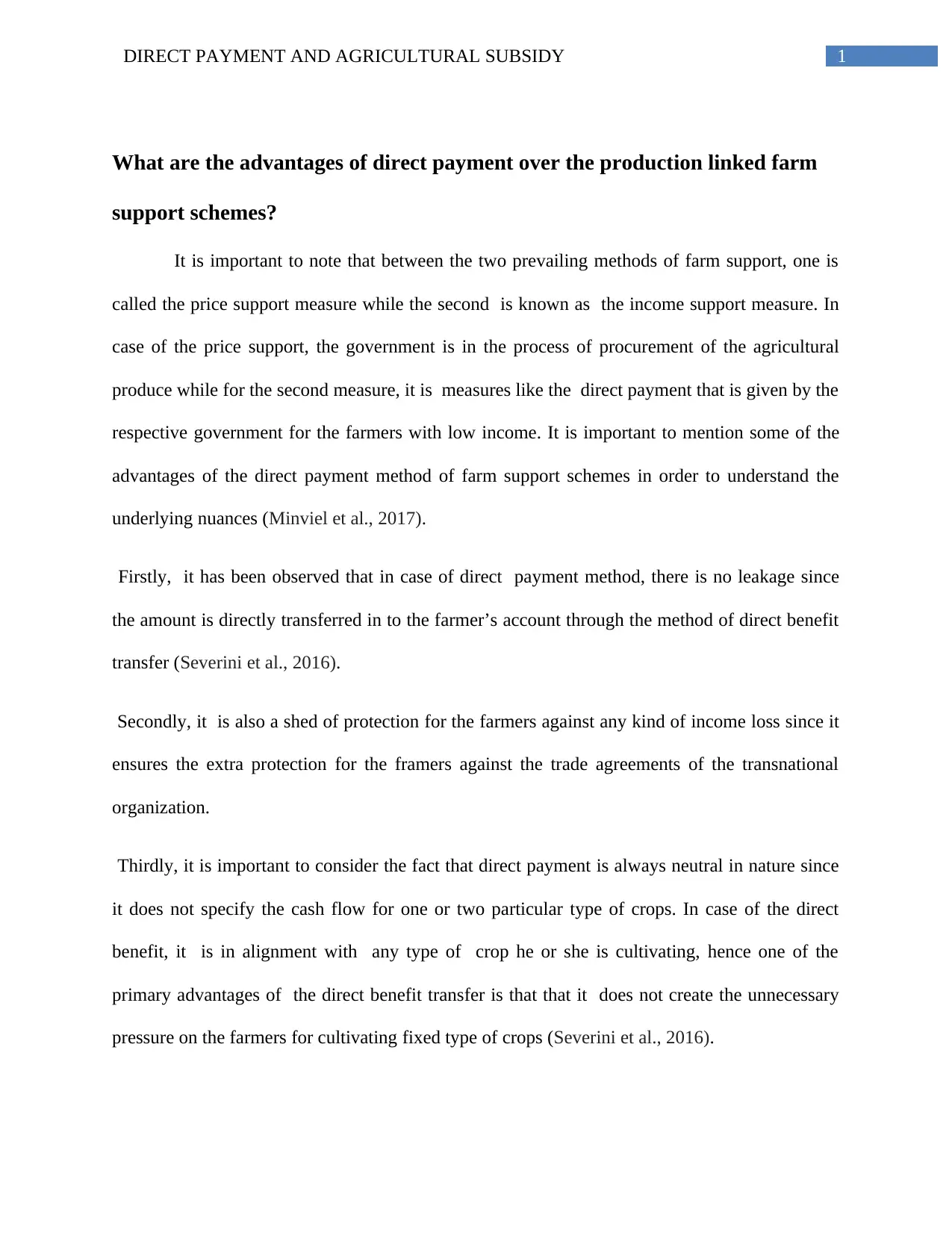
1DIRECT PAYMENT AND AGRICULTURAL SUBSIDY
What are the advantages of direct payment over the production linked farm
support schemes?
It is important to note that between the two prevailing methods of farm support, one is
called the price support measure while the second is known as the income support measure. In
case of the price support, the government is in the process of procurement of the agricultural
produce while for the second measure, it is measures like the direct payment that is given by the
respective government for the farmers with low income. It is important to mention some of the
advantages of the direct payment method of farm support schemes in order to understand the
underlying nuances (Minviel et al., 2017).
Firstly, it has been observed that in case of direct payment method, there is no leakage since
the amount is directly transferred in to the farmer’s account through the method of direct benefit
transfer (Severini et al., 2016).
Secondly, it is also a shed of protection for the farmers against any kind of income loss since it
ensures the extra protection for the framers against the trade agreements of the transnational
organization.
Thirdly, it is important to consider the fact that direct payment is always neutral in nature since
it does not specify the cash flow for one or two particular type of crops. In case of the direct
benefit, it is in alignment with any type of crop he or she is cultivating, hence one of the
primary advantages of the direct benefit transfer is that that it does not create the unnecessary
pressure on the farmers for cultivating fixed type of crops (Severini et al., 2016).
What are the advantages of direct payment over the production linked farm
support schemes?
It is important to note that between the two prevailing methods of farm support, one is
called the price support measure while the second is known as the income support measure. In
case of the price support, the government is in the process of procurement of the agricultural
produce while for the second measure, it is measures like the direct payment that is given by the
respective government for the farmers with low income. It is important to mention some of the
advantages of the direct payment method of farm support schemes in order to understand the
underlying nuances (Minviel et al., 2017).
Firstly, it has been observed that in case of direct payment method, there is no leakage since
the amount is directly transferred in to the farmer’s account through the method of direct benefit
transfer (Severini et al., 2016).
Secondly, it is also a shed of protection for the farmers against any kind of income loss since it
ensures the extra protection for the framers against the trade agreements of the transnational
organization.
Thirdly, it is important to consider the fact that direct payment is always neutral in nature since
it does not specify the cash flow for one or two particular type of crops. In case of the direct
benefit, it is in alignment with any type of crop he or she is cultivating, hence one of the
primary advantages of the direct benefit transfer is that that it does not create the unnecessary
pressure on the farmers for cultivating fixed type of crops (Severini et al., 2016).
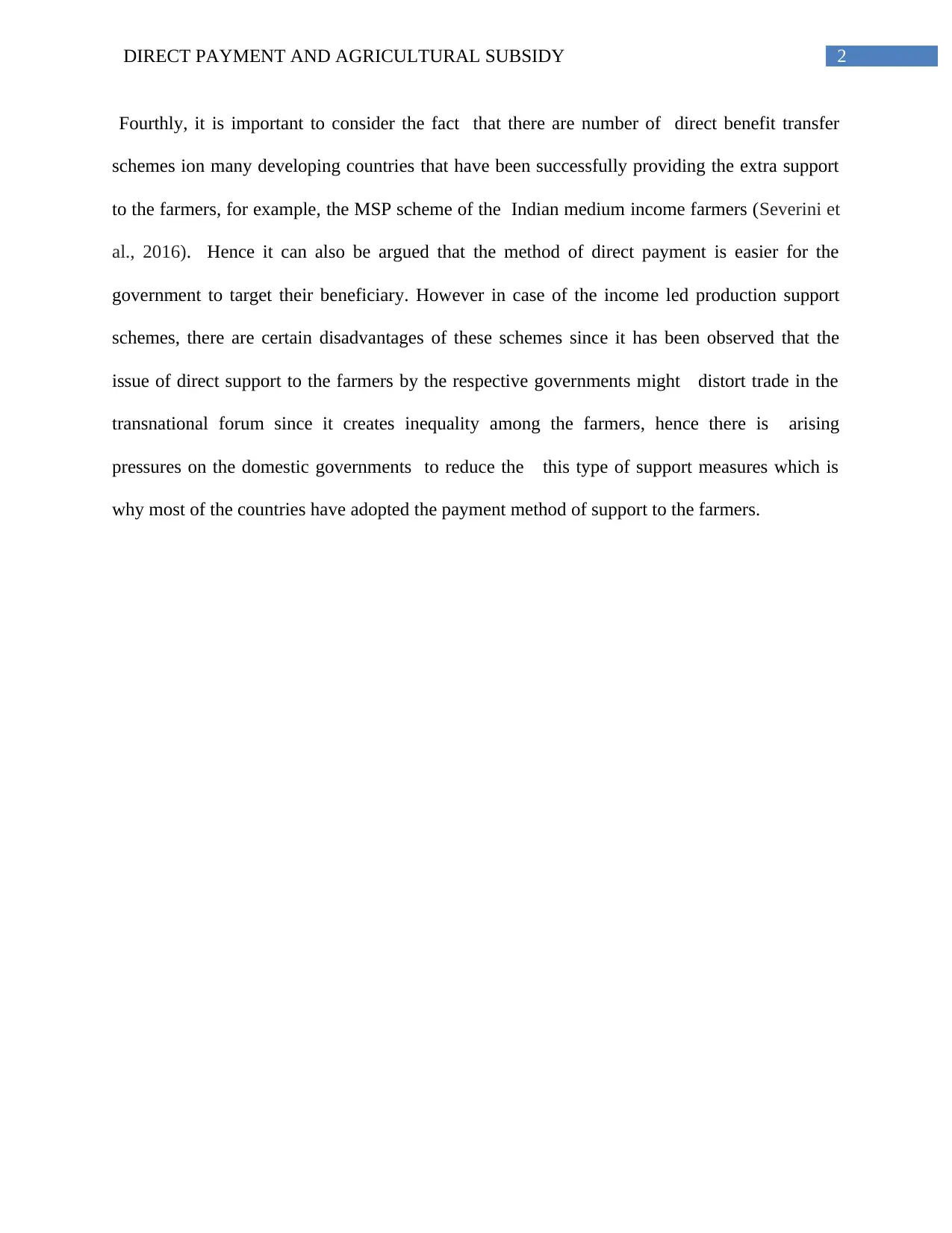
2DIRECT PAYMENT AND AGRICULTURAL SUBSIDY
Fourthly, it is important to consider the fact that there are number of direct benefit transfer
schemes ion many developing countries that have been successfully providing the extra support
to the farmers, for example, the MSP scheme of the Indian medium income farmers (Severini et
al., 2016). Hence it can also be argued that the method of direct payment is easier for the
government to target their beneficiary. However in case of the income led production support
schemes, there are certain disadvantages of these schemes since it has been observed that the
issue of direct support to the farmers by the respective governments might distort trade in the
transnational forum since it creates inequality among the farmers, hence there is arising
pressures on the domestic governments to reduce the this type of support measures which is
why most of the countries have adopted the payment method of support to the farmers.
Fourthly, it is important to consider the fact that there are number of direct benefit transfer
schemes ion many developing countries that have been successfully providing the extra support
to the farmers, for example, the MSP scheme of the Indian medium income farmers (Severini et
al., 2016). Hence it can also be argued that the method of direct payment is easier for the
government to target their beneficiary. However in case of the income led production support
schemes, there are certain disadvantages of these schemes since it has been observed that the
issue of direct support to the farmers by the respective governments might distort trade in the
transnational forum since it creates inequality among the farmers, hence there is arising
pressures on the domestic governments to reduce the this type of support measures which is
why most of the countries have adopted the payment method of support to the farmers.
⊘ This is a preview!⊘
Do you want full access?
Subscribe today to unlock all pages.

Trusted by 1+ million students worldwide
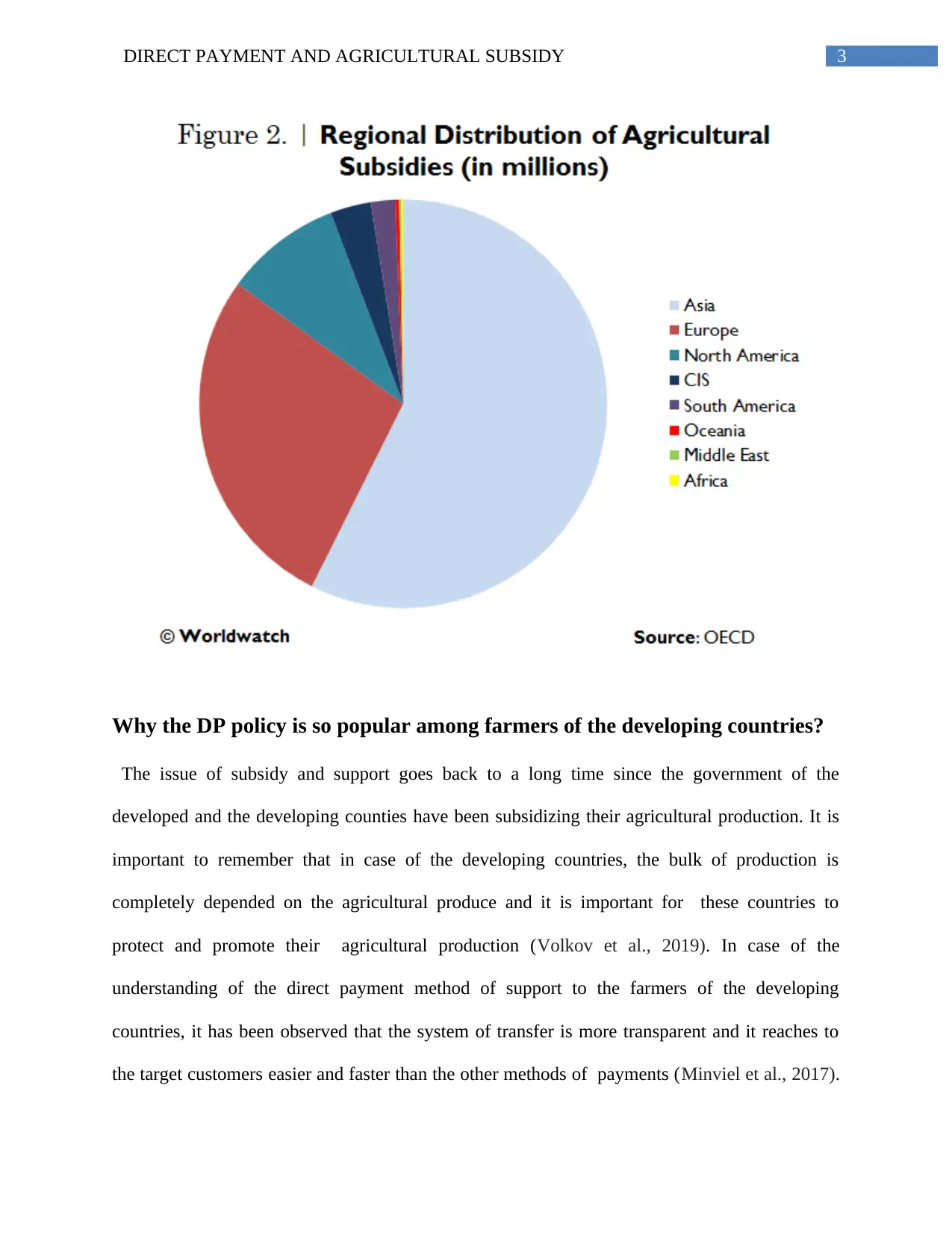
3DIRECT PAYMENT AND AGRICULTURAL SUBSIDY
Why the DP policy is so popular among farmers of the developing countries?
The issue of subsidy and support goes back to a long time since the government of the
developed and the developing counties have been subsidizing their agricultural production. It is
important to remember that in case of the developing countries, the bulk of production is
completely depended on the agricultural produce and it is important for these countries to
protect and promote their agricultural production (Volkov et al., 2019). In case of the
understanding of the direct payment method of support to the farmers of the developing
countries, it has been observed that the system of transfer is more transparent and it reaches to
the target customers easier and faster than the other methods of payments (Minviel et al., 2017).
Why the DP policy is so popular among farmers of the developing countries?
The issue of subsidy and support goes back to a long time since the government of the
developed and the developing counties have been subsidizing their agricultural production. It is
important to remember that in case of the developing countries, the bulk of production is
completely depended on the agricultural produce and it is important for these countries to
protect and promote their agricultural production (Volkov et al., 2019). In case of the
understanding of the direct payment method of support to the farmers of the developing
countries, it has been observed that the system of transfer is more transparent and it reaches to
the target customers easier and faster than the other methods of payments (Minviel et al., 2017).
Paraphrase This Document
Need a fresh take? Get an instant paraphrase of this document with our AI Paraphraser
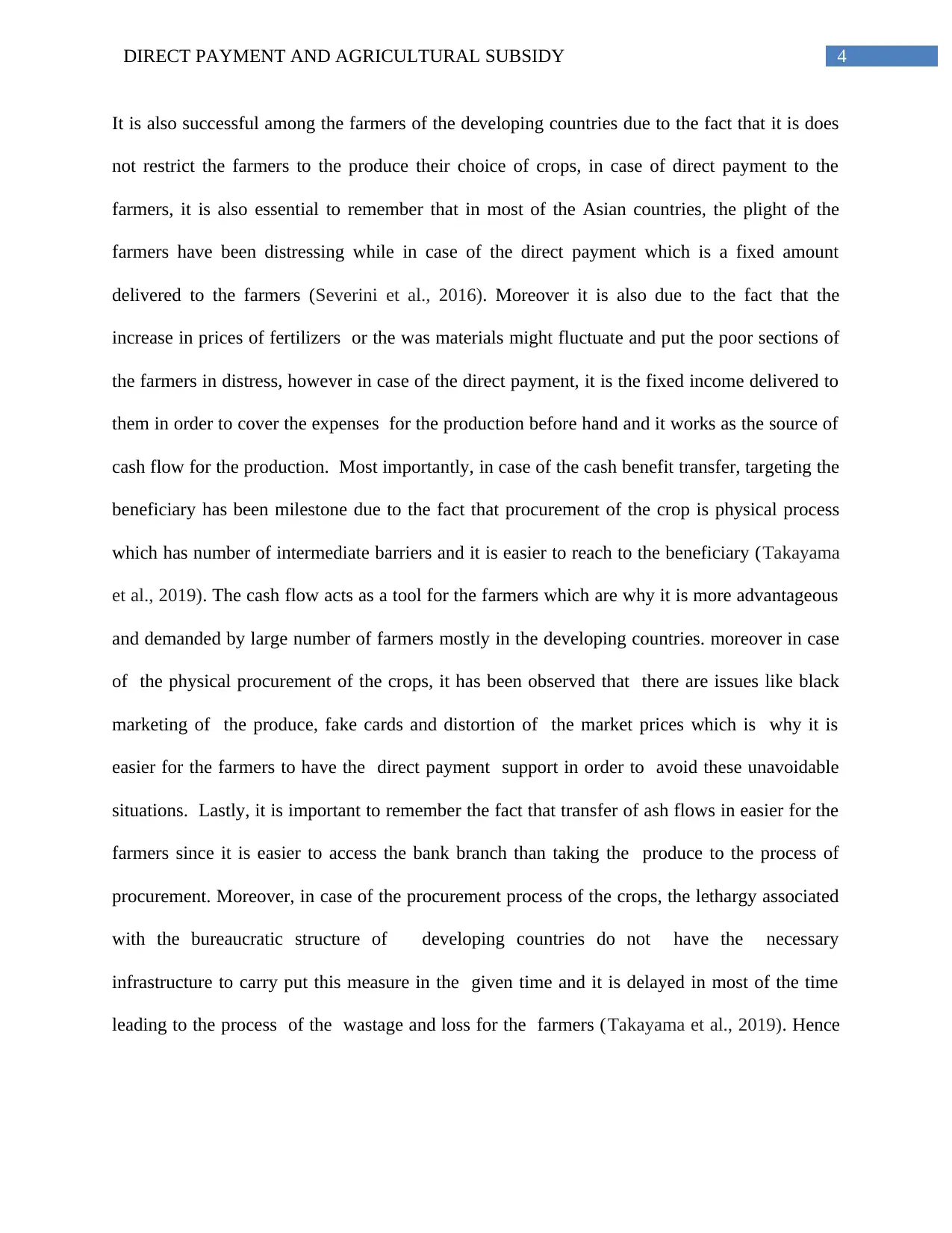
4DIRECT PAYMENT AND AGRICULTURAL SUBSIDY
It is also successful among the farmers of the developing countries due to the fact that it is does
not restrict the farmers to the produce their choice of crops, in case of direct payment to the
farmers, it is also essential to remember that in most of the Asian countries, the plight of the
farmers have been distressing while in case of the direct payment which is a fixed amount
delivered to the farmers (Severini et al., 2016). Moreover it is also due to the fact that the
increase in prices of fertilizers or the was materials might fluctuate and put the poor sections of
the farmers in distress, however in case of the direct payment, it is the fixed income delivered to
them in order to cover the expenses for the production before hand and it works as the source of
cash flow for the production. Most importantly, in case of the cash benefit transfer, targeting the
beneficiary has been milestone due to the fact that procurement of the crop is physical process
which has number of intermediate barriers and it is easier to reach to the beneficiary (Takayama
et al., 2019). The cash flow acts as a tool for the farmers which are why it is more advantageous
and demanded by large number of farmers mostly in the developing countries. moreover in case
of the physical procurement of the crops, it has been observed that there are issues like black
marketing of the produce, fake cards and distortion of the market prices which is why it is
easier for the farmers to have the direct payment support in order to avoid these unavoidable
situations. Lastly, it is important to remember the fact that transfer of ash flows in easier for the
farmers since it is easier to access the bank branch than taking the produce to the process of
procurement. Moreover, in case of the procurement process of the crops, the lethargy associated
with the bureaucratic structure of developing countries do not have the necessary
infrastructure to carry put this measure in the given time and it is delayed in most of the time
leading to the process of the wastage and loss for the farmers (Takayama et al., 2019). Hence
It is also successful among the farmers of the developing countries due to the fact that it is does
not restrict the farmers to the produce their choice of crops, in case of direct payment to the
farmers, it is also essential to remember that in most of the Asian countries, the plight of the
farmers have been distressing while in case of the direct payment which is a fixed amount
delivered to the farmers (Severini et al., 2016). Moreover it is also due to the fact that the
increase in prices of fertilizers or the was materials might fluctuate and put the poor sections of
the farmers in distress, however in case of the direct payment, it is the fixed income delivered to
them in order to cover the expenses for the production before hand and it works as the source of
cash flow for the production. Most importantly, in case of the cash benefit transfer, targeting the
beneficiary has been milestone due to the fact that procurement of the crop is physical process
which has number of intermediate barriers and it is easier to reach to the beneficiary (Takayama
et al., 2019). The cash flow acts as a tool for the farmers which are why it is more advantageous
and demanded by large number of farmers mostly in the developing countries. moreover in case
of the physical procurement of the crops, it has been observed that there are issues like black
marketing of the produce, fake cards and distortion of the market prices which is why it is
easier for the farmers to have the direct payment support in order to avoid these unavoidable
situations. Lastly, it is important to remember the fact that transfer of ash flows in easier for the
farmers since it is easier to access the bank branch than taking the produce to the process of
procurement. Moreover, in case of the procurement process of the crops, the lethargy associated
with the bureaucratic structure of developing countries do not have the necessary
infrastructure to carry put this measure in the given time and it is delayed in most of the time
leading to the process of the wastage and loss for the farmers (Takayama et al., 2019). Hence
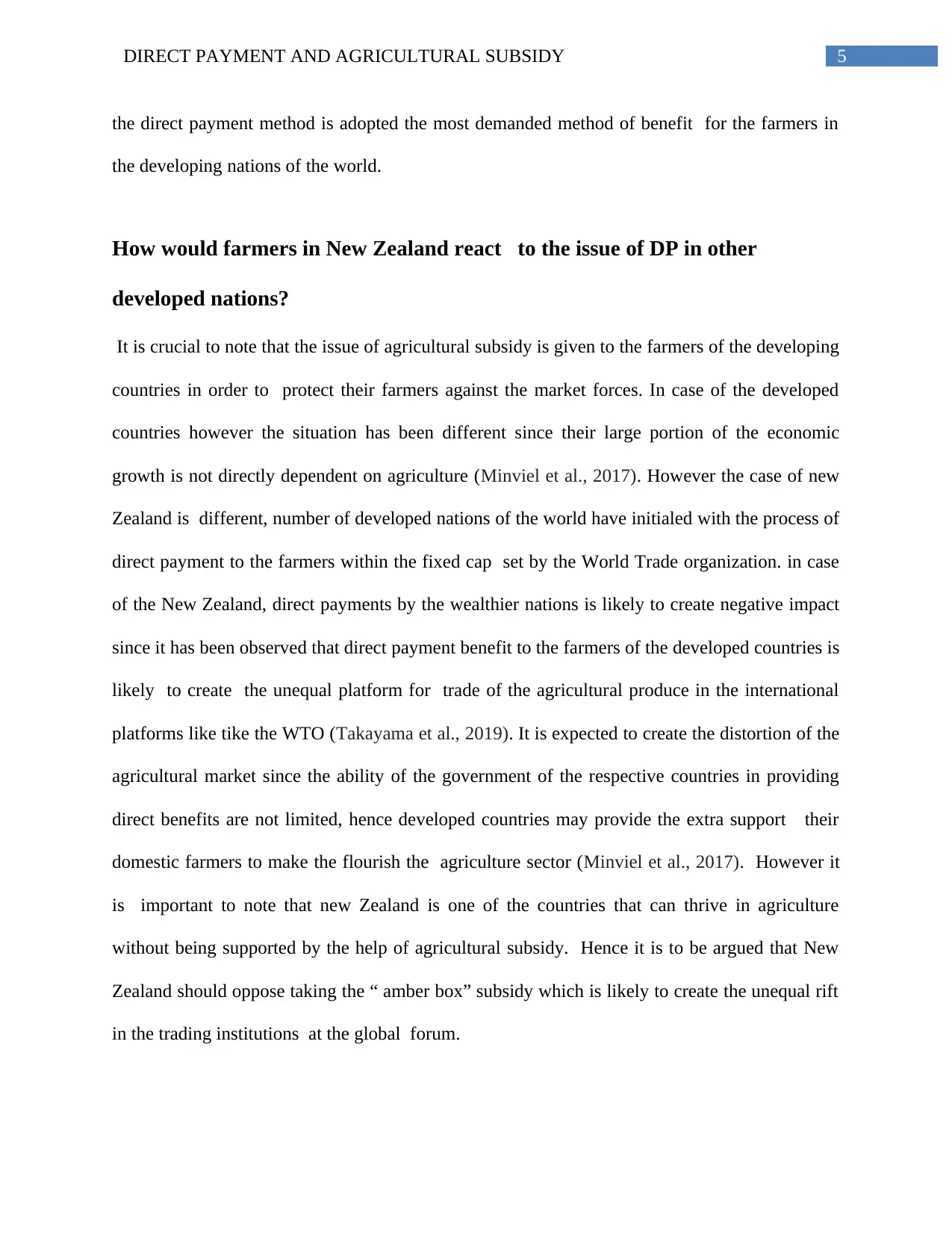
5DIRECT PAYMENT AND AGRICULTURAL SUBSIDY
the direct payment method is adopted the most demanded method of benefit for the farmers in
the developing nations of the world.
How would farmers in New Zealand react to the issue of DP in other
developed nations?
It is crucial to note that the issue of agricultural subsidy is given to the farmers of the developing
countries in order to protect their farmers against the market forces. In case of the developed
countries however the situation has been different since their large portion of the economic
growth is not directly dependent on agriculture (Minviel et al., 2017). However the case of new
Zealand is different, number of developed nations of the world have initialed with the process of
direct payment to the farmers within the fixed cap set by the World Trade organization. in case
of the New Zealand, direct payments by the wealthier nations is likely to create negative impact
since it has been observed that direct payment benefit to the farmers of the developed countries is
likely to create the unequal platform for trade of the agricultural produce in the international
platforms like tike the WTO (Takayama et al., 2019). It is expected to create the distortion of the
agricultural market since the ability of the government of the respective countries in providing
direct benefits are not limited, hence developed countries may provide the extra support their
domestic farmers to make the flourish the agriculture sector (Minviel et al., 2017). However it
is important to note that new Zealand is one of the countries that can thrive in agriculture
without being supported by the help of agricultural subsidy. Hence it is to be argued that New
Zealand should oppose taking the “ amber box” subsidy which is likely to create the unequal rift
in the trading institutions at the global forum.
the direct payment method is adopted the most demanded method of benefit for the farmers in
the developing nations of the world.
How would farmers in New Zealand react to the issue of DP in other
developed nations?
It is crucial to note that the issue of agricultural subsidy is given to the farmers of the developing
countries in order to protect their farmers against the market forces. In case of the developed
countries however the situation has been different since their large portion of the economic
growth is not directly dependent on agriculture (Minviel et al., 2017). However the case of new
Zealand is different, number of developed nations of the world have initialed with the process of
direct payment to the farmers within the fixed cap set by the World Trade organization. in case
of the New Zealand, direct payments by the wealthier nations is likely to create negative impact
since it has been observed that direct payment benefit to the farmers of the developed countries is
likely to create the unequal platform for trade of the agricultural produce in the international
platforms like tike the WTO (Takayama et al., 2019). It is expected to create the distortion of the
agricultural market since the ability of the government of the respective countries in providing
direct benefits are not limited, hence developed countries may provide the extra support their
domestic farmers to make the flourish the agriculture sector (Minviel et al., 2017). However it
is important to note that new Zealand is one of the countries that can thrive in agriculture
without being supported by the help of agricultural subsidy. Hence it is to be argued that New
Zealand should oppose taking the “ amber box” subsidy which is likely to create the unequal rift
in the trading institutions at the global forum.
⊘ This is a preview!⊘
Do you want full access?
Subscribe today to unlock all pages.

Trusted by 1+ million students worldwide
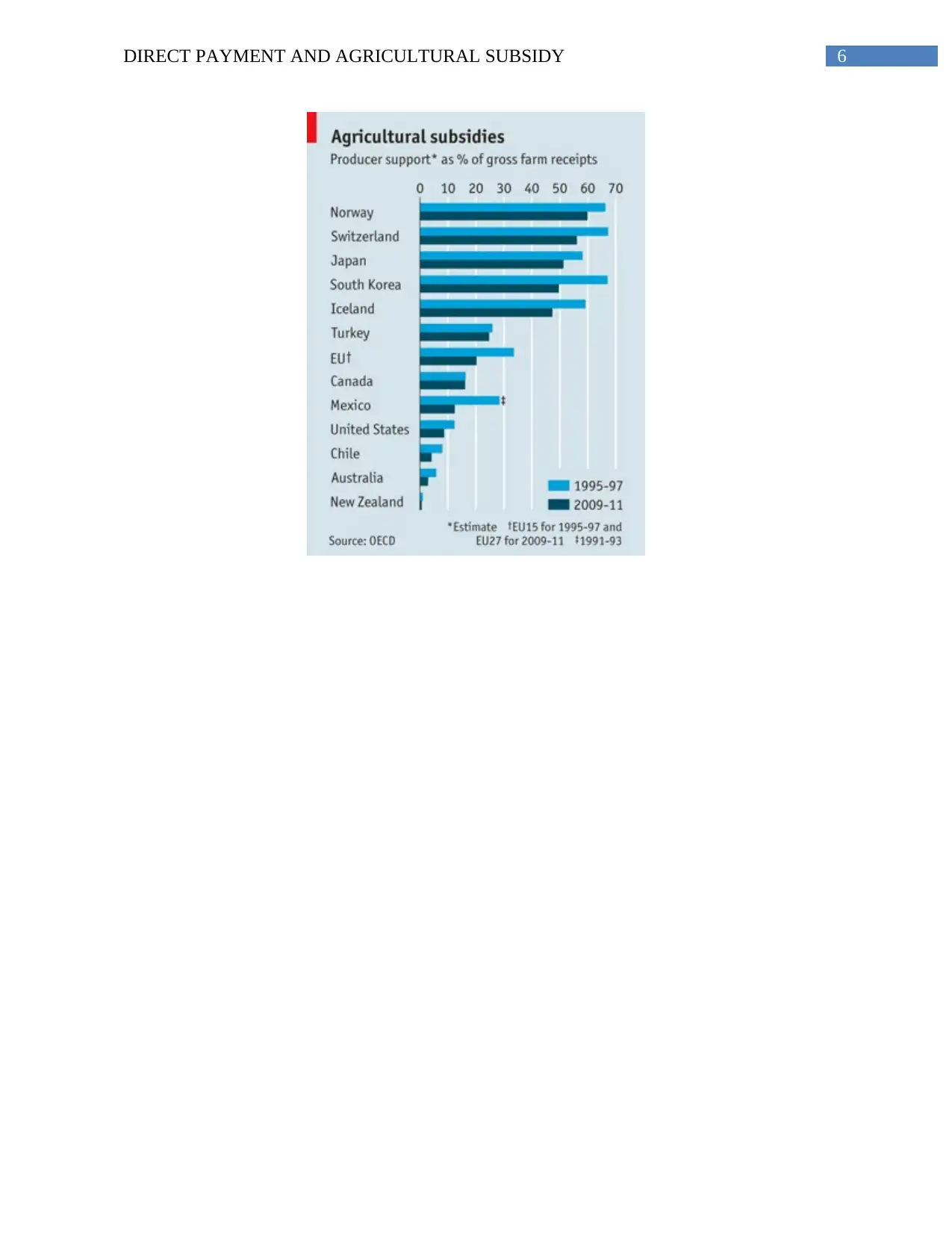
6DIRECT PAYMENT AND AGRICULTURAL SUBSIDY
Paraphrase This Document
Need a fresh take? Get an instant paraphrase of this document with our AI Paraphraser
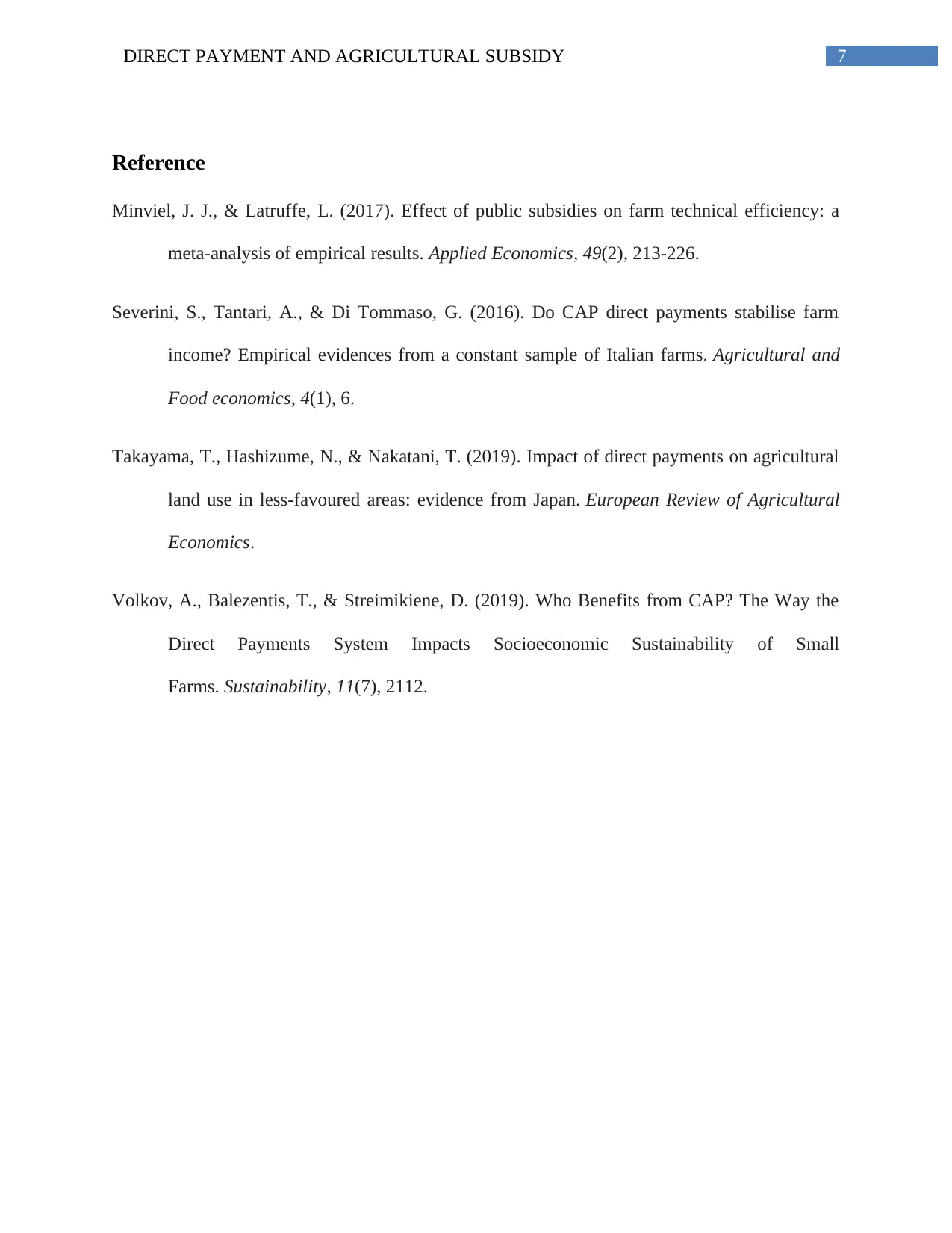
7DIRECT PAYMENT AND AGRICULTURAL SUBSIDY
Reference
Minviel, J. J., & Latruffe, L. (2017). Effect of public subsidies on farm technical efficiency: a
meta-analysis of empirical results. Applied Economics, 49(2), 213-226.
Severini, S., Tantari, A., & Di Tommaso, G. (2016). Do CAP direct payments stabilise farm
income? Empirical evidences from a constant sample of Italian farms. Agricultural and
Food economics, 4(1), 6.
Takayama, T., Hashizume, N., & Nakatani, T. (2019). Impact of direct payments on agricultural
land use in less-favoured areas: evidence from Japan. European Review of Agricultural
Economics.
Volkov, A., Balezentis, T., & Streimikiene, D. (2019). Who Benefits from CAP? The Way the
Direct Payments System Impacts Socioeconomic Sustainability of Small
Farms. Sustainability, 11(7), 2112.
Reference
Minviel, J. J., & Latruffe, L. (2017). Effect of public subsidies on farm technical efficiency: a
meta-analysis of empirical results. Applied Economics, 49(2), 213-226.
Severini, S., Tantari, A., & Di Tommaso, G. (2016). Do CAP direct payments stabilise farm
income? Empirical evidences from a constant sample of Italian farms. Agricultural and
Food economics, 4(1), 6.
Takayama, T., Hashizume, N., & Nakatani, T. (2019). Impact of direct payments on agricultural
land use in less-favoured areas: evidence from Japan. European Review of Agricultural
Economics.
Volkov, A., Balezentis, T., & Streimikiene, D. (2019). Who Benefits from CAP? The Way the
Direct Payments System Impacts Socioeconomic Sustainability of Small
Farms. Sustainability, 11(7), 2112.
1 out of 8
Related Documents
Your All-in-One AI-Powered Toolkit for Academic Success.
+13062052269
info@desklib.com
Available 24*7 on WhatsApp / Email
![[object Object]](/_next/static/media/star-bottom.7253800d.svg)
Unlock your academic potential
Copyright © 2020–2025 A2Z Services. All Rights Reserved. Developed and managed by ZUCOL.





